Mike and I were talking today about just what our digitization project has accomplished. This was in response to a meeting we'd attended where it was brought up that many researchers today think if something's not on the Internet, it doesn't exist and/or it doesn't matter (it must not be significant if it's not worth digitizing). For those of you reading this blog, I can imagine you either shaking or nodding your head - you've heard this before or just can't believe people think that way. But I heard it in library school so it must be so.
Anyway, this segued into talking about the first collection we scanned as a part of this project, in 2005 - the MAMAS collection. That stands for Museum and Medical Arts Services. I blogged briefly about MAMAS way back in this blog's infancy but, in short, MAMAS photographers were dispatched to the European and Pacific theaters during World War 2 to document the medical treatment the troops were getting. We scanned a dozen or so boxes of photos and realized we had very little from Europe. Didn't know where they were but they weren't in this batch of boxes.
Fast forward to late 2007. Over the years the archives has rescued countless documents that were being discarded for whatever reason. We've begun to dig through them and in the sort we realized that what we had were several hundred MAMAS photos from Europe. Happy day, and exciting. They're now in the process of being cataloged and will be scanned some time this year.
And so, this is the source of this post's title. If we hadn't scanned the first, "known" batch of MAMAS, we would never have "known" that these several hundred (and most likely will top 1000) photos were also part of that collection.
An unofficial blog about the National Museum of Health and Medicine (nee the Army Medical Museum) in Silver Spring, MD. Visit for news about the museum, new projects, musing on the history of medicine and neat pictures.
Showing posts with label photographs. Show all posts
Showing posts with label photographs. Show all posts
Tuesday, April 15, 2008
The more you know, the more you know
Sunday, April 6, 2008
the week on flickr - Korean war body armor, Civil War and mosquitoes
April 4th:
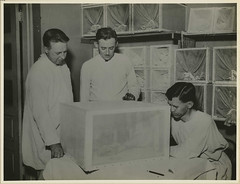
Emergency encephalitis laboratory. Jefferson Barracks, Missouri. (Major Cornell, Simmons and Sergeant Rhodes.) [The volunteer has put his arm in a screened cage to be bitten by mosquitoes. Scene. Laboratories. Military camps.]

Armored Vest Number 329 worn by Private 1st Class Willie Tufts, US 52077771, with bullet holes circled and marked 1, 2, 3, 4, and 5. Company E, 7th Regiment. Front view. 04/26/1952. [Korean War]
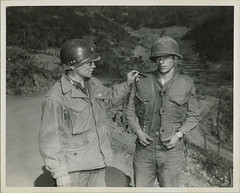
Captain Robert Bessey, Jr. (Cincinnati, OH), Infantry member of the Body Armor Team I, Company 15, Infantry Regiment, 30 Division, points to fragment hole in vest worn by Private Edward Schallack (4905 N. 36 St., Milwaukee, WI) who wore the vest on patrol. 04/24/1952. [Korean War]
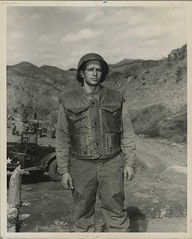
Private 1st Class Leo Curran, Jr., 46 1/2 Allen Street, Hudson, NY. E Company, 7th Regiment, 3rd Division. Was hit in back with fragment while wearing body armor vest on patrol. No penetration. 04/18/1952. [Korean War]
April 1st:

"Gunshot wound of hip." Private William W. Wrightman, Co. L, 2nd New York Heavy Artillery. Wounded at Petersburg, VA on March 31, 1865. Treated by Reed Bontecou at Harewood Hospital.[Civil War]

Emergency encephalitis laboratory. Jefferson Barracks, Missouri. (Major Cornell, Simmons and Sergeant Rhodes.) [The volunteer has put his arm in a screened cage to be bitten by mosquitoes. Scene. Laboratories. Military camps.]

Armored Vest Number 329 worn by Private 1st Class Willie Tufts, US 52077771, with bullet holes circled and marked 1, 2, 3, 4, and 5. Company E, 7th Regiment. Front view. 04/26/1952. [Korean War]

Captain Robert Bessey, Jr. (Cincinnati, OH), Infantry member of the Body Armor Team I, Company 15, Infantry Regiment, 30 Division, points to fragment hole in vest worn by Private Edward Schallack (4905 N. 36 St., Milwaukee, WI) who wore the vest on patrol. 04/24/1952. [Korean War]

Private 1st Class Leo Curran, Jr., 46 1/2 Allen Street, Hudson, NY. E Company, 7th Regiment, 3rd Division. Was hit in back with fragment while wearing body armor vest on patrol. No penetration. 04/18/1952. [Korean War]
April 1st:

"Gunshot wound of hip." Private William W. Wrightman, Co. L, 2nd New York Heavy Artillery. Wounded at Petersburg, VA on March 31, 1865. Treated by Reed Bontecou at Harewood Hospital.[Civil War]
Tuesday, April 1, 2008
Another Civil War upload to the Internet Archive
Today we uploaded anther book to the Internet Archive, but instead of a text, this one is a photograph album. Given to Frances Pleasants by wounded soldiers she cared for during the Civil War in Germantown, Pennsylvania, it holds photographs, tintypes, and cartes-de-visite, as well as newspaper clippings.

Labels:
Civil War,
Otis Historical Archives,
photographs
Sunday, March 30, 2008
the week in flickr
Last week's pictures posted on flickr -
March 28th:
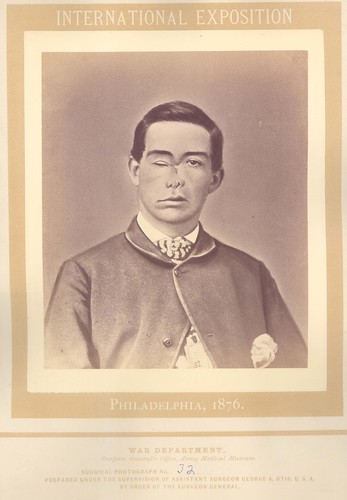 "Shell Wound of Face." Pvt. William H. Nims, Co. D, 61st New York Volunteers, wounded at Petersburg, VA.
"Shell Wound of Face." Pvt. William H. Nims, Co. D, 61st New York Volunteers, wounded at Petersburg, VA.
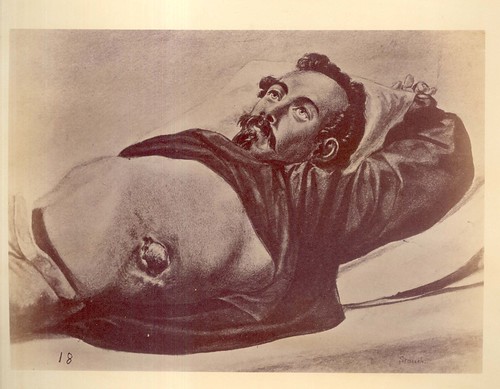 "Penetrating gunshot would of the thorax and abdomen. A round musket ball having entered the left pleural cavity, passed through the diaphragm, and thence into some part of the intestinal canal. Recovery." Capt. Robert Stolpe, Co. A, 29th New York, wounded at battle of Chancellorsville, May 2, 1863. Artwork by E. Stauch.
"Penetrating gunshot would of the thorax and abdomen. A round musket ball having entered the left pleural cavity, passed through the diaphragm, and thence into some part of the intestinal canal. Recovery." Capt. Robert Stolpe, Co. A, 29th New York, wounded at battle of Chancellorsville, May 2, 1863. Artwork by E. Stauch.
 "Doing Cure in Kiosk, 16* below Zero." A free tuberculosis clinic in White Haven, Pennsylvania. Probably early 20th century.
"Doing Cure in Kiosk, 16* below Zero." A free tuberculosis clinic in White Haven, Pennsylvania. Probably early 20th century.
March 27th:
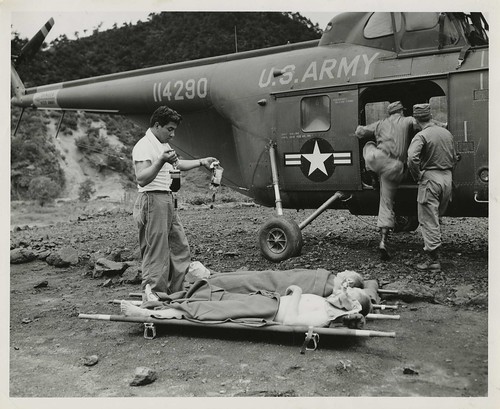 Unloading wounded from helicopter. Attendant holds IV [intravenous therapy] for patients. [First aid. Stretchers. Transfusions. Transport of sick and wounded.] Korean War. Photo from Walter Reed Army Institute of Research.
Unloading wounded from helicopter. Attendant holds IV [intravenous therapy] for patients. [First aid. Stretchers. Transfusions. Transport of sick and wounded.] Korean War. Photo from Walter Reed Army Institute of Research.
 The operation of a new litter designed to be attached to Bell helicopters used in air evacuation of the wounded from the front lines. The litter was designed by Captain Sebourn. [Transport of sick and wounded. Evacuations. Aircraft.] Korean War.
The operation of a new litter designed to be attached to Bell helicopters used in air evacuation of the wounded from the front lines. The litter was designed by Captain Sebourn. [Transport of sick and wounded. Evacuations. Aircraft.] Korean War.
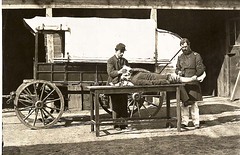 "Army Medical Wagon"
"Army Medical Wagon"
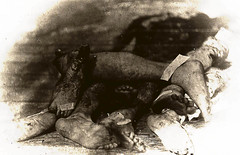 "Field Day". Amputations at Harewood Hospital in Washington, DC. Photograph from Reed Bontecou.
"Field Day". Amputations at Harewood Hospital in Washington, DC. Photograph from Reed Bontecou.
March 25th:
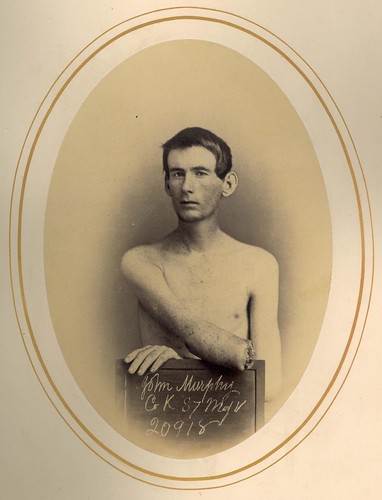 "Amputation of Forearm". Pvt. John Murphy, Co. K, 37 Massachusetts Volunteers. Wounded at Battle of Harper's Farm, VA on April 6, 1865. Treated by Dr. Reed Bontecou at Harewood Hospital, Washington, DC who had the photograph taken.
"Amputation of Forearm". Pvt. John Murphy, Co. K, 37 Massachusetts Volunteers. Wounded at Battle of Harper's Farm, VA on April 6, 1865. Treated by Dr. Reed Bontecou at Harewood Hospital, Washington, DC who had the photograph taken.
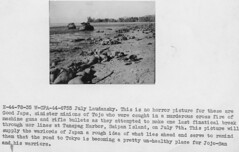 "This is no horror picture for these are Good Japs, sinister minions of Tojo who were caught in a murderous cross fire of machine guns and rifle bullets as they attempted to make one last [fanatical] break through [our] lines at Tanapag Harbor, Saipan Island, on July 7th. This picture will supply the warlords of Japan a rough idea of what lies ahead and serve to remind them that the road to Tokyo is becoming a pretty un-healthy place for Tojo-san and his warriors." W-CPA-44-6755 July Laudansky. World War 2. 10/1/1944.
"This is no horror picture for these are Good Japs, sinister minions of Tojo who were caught in a murderous cross fire of machine guns and rifle bullets as they attempted to make one last [fanatical] break through [our] lines at Tanapag Harbor, Saipan Island, on July 7th. This picture will supply the warlords of Japan a rough idea of what lies ahead and serve to remind them that the road to Tokyo is becoming a pretty un-healthy place for Tojo-san and his warriors." W-CPA-44-6755 July Laudansky. World War 2. 10/1/1944.
See a discussion of this picture and caption.
March 28th:
 "Shell Wound of Face." Pvt. William H. Nims, Co. D, 61st New York Volunteers, wounded at Petersburg, VA.
"Shell Wound of Face." Pvt. William H. Nims, Co. D, 61st New York Volunteers, wounded at Petersburg, VA. "Penetrating gunshot would of the thorax and abdomen. A round musket ball having entered the left pleural cavity, passed through the diaphragm, and thence into some part of the intestinal canal. Recovery." Capt. Robert Stolpe, Co. A, 29th New York, wounded at battle of Chancellorsville, May 2, 1863. Artwork by E. Stauch.
"Penetrating gunshot would of the thorax and abdomen. A round musket ball having entered the left pleural cavity, passed through the diaphragm, and thence into some part of the intestinal canal. Recovery." Capt. Robert Stolpe, Co. A, 29th New York, wounded at battle of Chancellorsville, May 2, 1863. Artwork by E. Stauch. "Doing Cure in Kiosk, 16* below Zero." A free tuberculosis clinic in White Haven, Pennsylvania. Probably early 20th century.
"Doing Cure in Kiosk, 16* below Zero." A free tuberculosis clinic in White Haven, Pennsylvania. Probably early 20th century. March 27th:
 Unloading wounded from helicopter. Attendant holds IV [intravenous therapy] for patients. [First aid. Stretchers. Transfusions. Transport of sick and wounded.] Korean War. Photo from Walter Reed Army Institute of Research.
Unloading wounded from helicopter. Attendant holds IV [intravenous therapy] for patients. [First aid. Stretchers. Transfusions. Transport of sick and wounded.] Korean War. Photo from Walter Reed Army Institute of Research. The operation of a new litter designed to be attached to Bell helicopters used in air evacuation of the wounded from the front lines. The litter was designed by Captain Sebourn. [Transport of sick and wounded. Evacuations. Aircraft.] Korean War.
The operation of a new litter designed to be attached to Bell helicopters used in air evacuation of the wounded from the front lines. The litter was designed by Captain Sebourn. [Transport of sick and wounded. Evacuations. Aircraft.] Korean War. "Army Medical Wagon"
"Army Medical Wagon" "Field Day". Amputations at Harewood Hospital in Washington, DC. Photograph from Reed Bontecou.
"Field Day". Amputations at Harewood Hospital in Washington, DC. Photograph from Reed Bontecou.March 25th:
 "Amputation of Forearm". Pvt. John Murphy, Co. K, 37 Massachusetts Volunteers. Wounded at Battle of Harper's Farm, VA on April 6, 1865. Treated by Dr. Reed Bontecou at Harewood Hospital, Washington, DC who had the photograph taken.
"Amputation of Forearm". Pvt. John Murphy, Co. K, 37 Massachusetts Volunteers. Wounded at Battle of Harper's Farm, VA on April 6, 1865. Treated by Dr. Reed Bontecou at Harewood Hospital, Washington, DC who had the photograph taken. "This is no horror picture for these are Good Japs, sinister minions of Tojo who were caught in a murderous cross fire of machine guns and rifle bullets as they attempted to make one last [fanatical] break through [our] lines at Tanapag Harbor, Saipan Island, on July 7th. This picture will supply the warlords of Japan a rough idea of what lies ahead and serve to remind them that the road to Tokyo is becoming a pretty un-healthy place for Tojo-san and his warriors." W-CPA-44-6755 July Laudansky. World War 2. 10/1/1944.
"This is no horror picture for these are Good Japs, sinister minions of Tojo who were caught in a murderous cross fire of machine guns and rifle bullets as they attempted to make one last [fanatical] break through [our] lines at Tanapag Harbor, Saipan Island, on July 7th. This picture will supply the warlords of Japan a rough idea of what lies ahead and serve to remind them that the road to Tokyo is becoming a pretty un-healthy place for Tojo-san and his warriors." W-CPA-44-6755 July Laudansky. World War 2. 10/1/1944. See a discussion of this picture and caption.
Monday, March 24, 2008
Nationalism, racism or a time that tried men's souls?
Here's a picture from the MAMAS collection that Kathleen ran across today:

Unpleasant, but typical of war photography, right?
Now here's the picture with the caption scanned in:
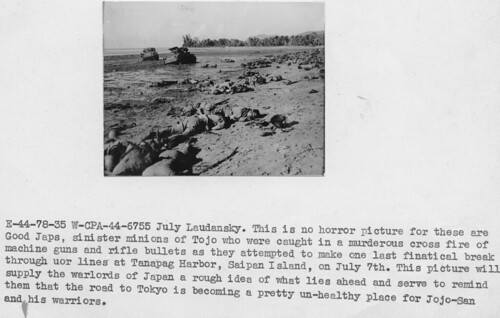
The caption reads, "This is no horror picture for these are Good Japs, sinister minions of Tojo who were caught in a murderous cross fire of machine guns and rifle bullets as they attempted to make one last [fanatical] break through [our] lines at Tanapag Harbor, Saipan Island, on July 7th. This picture will supply the warlords of Japan a rough idea of what lies ahead and serve to remind them that the road to Tokyo is becoming a pretty un-healthy place for Tojo-san and his warriors." W-CPA-44-6755 July Laudansky. 10/1/1944.
As a policy, we use the caption that the picture comes with, although we'll add additional information in brackets if necessary. This caption? It's unpleasant, but it's probably not propaganda as it was never meant to be seen except by the Museum staff who received it. Unfortunately Mr. Laudansky was almost certainly on Saipan taking photographs when these Japanese soldiers attacked (to the last man), so I think we can understand this caption as an expression of something more than either nationalism or racism too. I'd like to hope that we as a society have moved beyond some things, but if I was in Laudansky's shoes, I have no idea what I'd write. I know I'd have been terrified though.
Although in our numbering series for the Museum & Medical Arts Service, I think this photograph is a re-photograph of by MAMAS staff of Luadansky's picture for the Central Pacific Area Signal Corps group.

Unpleasant, but typical of war photography, right?
Now here's the picture with the caption scanned in:

The caption reads, "This is no horror picture for these are Good Japs, sinister minions of Tojo who were caught in a murderous cross fire of machine guns and rifle bullets as they attempted to make one last [fanatical] break through [our] lines at Tanapag Harbor, Saipan Island, on July 7th. This picture will supply the warlords of Japan a rough idea of what lies ahead and serve to remind them that the road to Tokyo is becoming a pretty un-healthy place for Tojo-san and his warriors." W-CPA-44-6755 July Laudansky. 10/1/1944.
As a policy, we use the caption that the picture comes with, although we'll add additional information in brackets if necessary. This caption? It's unpleasant, but it's probably not propaganda as it was never meant to be seen except by the Museum staff who received it. Unfortunately Mr. Laudansky was almost certainly on Saipan taking photographs when these Japanese soldiers attacked (to the last man), so I think we can understand this caption as an expression of something more than either nationalism or racism too. I'd like to hope that we as a society have moved beyond some things, but if I was in Laudansky's shoes, I have no idea what I'd write. I know I'd have been terrified though.
Although in our numbering series for the Museum & Medical Arts Service, I think this photograph is a re-photograph of by MAMAS staff of Luadansky's picture for the Central Pacific Area Signal Corps group.
Thursday, March 20, 2008
This week's flickr pictures
Kathleen and I have been putting up a few pics this week as the fancy has struck us. Check these out:
March 17th:
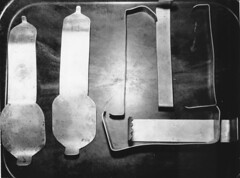
Retractors made from scrap metal. 44th Field Hospital, 8th Detachment. World War 2. 09/23/1945.
March 18:

"Gunshot fracture of left superior maxilla." Private Henry Morgan, Co. D, 77th New York Volunteers, wounded at Petersburgh, VA on April 2, 1865. Treated at Harewood Hospital, Washington DC, by Dr. Reed B. Bontecou who also had the photograph made.
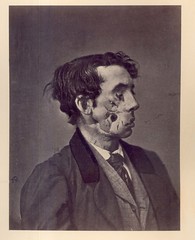
"Shell Wound of the face, with great destruction of the soft parts." Private Joseph Harvey, Co. C, 149th New York Volunteers. Wounded at Chancellorsville, Virginia on May 3 1863.
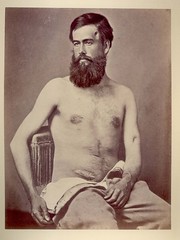
"Case of Corporal Bemis, Thrice Severely Wounded in Three Battles." Cpl. Edson D. Bemis, Co. K, 12th Massachussetts, wounded at Battles of Hatcher's Run, the Wilderness and Antietam.
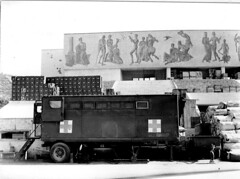
Mobile Optical Unit. 4th Medical Depot, Italy. 06/07/1944.
March 19:

Detachment of Hospital Corps taking patients over obstacles on the way to the hospital. Illustrating the equipment and operation of the brigade field hospital. Exhibit of the Army Medical Department, Pan-American Exposition, Buffalo, New York, 1901.

"Saboteuse" - World War II venereal disease prevention poster by editorial cartoonist C.D. Batchelor for the American Social Hygiene Association.
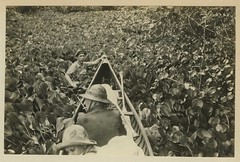
Panama. Dr. H.C. Clark. Gorgas Hospital. Ancon, Canal Zone. Club canoe forcing way through hyacinth beds, Pacora.
March 20:
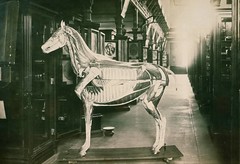
Comparative anatomy, Auzoux model of horse, life size. Specimen no. 2635. [papier mache, on display in Army Medical Museum] (We no longer have the model, although one can be seen in the Science Museum in London. This one's for Morbid Anatomy).

An enlisted technician rides along with patient to ground level to insure safety. from a series: "Air Evacuation from China to India," Patients flown over the 'hump' from China to India to be admitted to the 142nd General Hospital for further disposition.
More information about each picture can be seen on our flickr site. Visit our 3rd flickr page regularly, or sign up to be a contact so you know when new pictures go up.
March 17th:

Retractors made from scrap metal. 44th Field Hospital, 8th Detachment. World War 2. 09/23/1945.
March 18:

"Gunshot fracture of left superior maxilla." Private Henry Morgan, Co. D, 77th New York Volunteers, wounded at Petersburgh, VA on April 2, 1865. Treated at Harewood Hospital, Washington DC, by Dr. Reed B. Bontecou who also had the photograph made.

"Shell Wound of the face, with great destruction of the soft parts." Private Joseph Harvey, Co. C, 149th New York Volunteers. Wounded at Chancellorsville, Virginia on May 3 1863.

"Case of Corporal Bemis, Thrice Severely Wounded in Three Battles." Cpl. Edson D. Bemis, Co. K, 12th Massachussetts, wounded at Battles of Hatcher's Run, the Wilderness and Antietam.

Mobile Optical Unit. 4th Medical Depot, Italy. 06/07/1944.
March 19:

Detachment of Hospital Corps taking patients over obstacles on the way to the hospital. Illustrating the equipment and operation of the brigade field hospital. Exhibit of the Army Medical Department, Pan-American Exposition, Buffalo, New York, 1901.

"Saboteuse" - World War II venereal disease prevention poster by editorial cartoonist C.D. Batchelor for the American Social Hygiene Association.

Panama. Dr. H.C. Clark. Gorgas Hospital. Ancon, Canal Zone. Club canoe forcing way through hyacinth beds, Pacora.
March 20:

Comparative anatomy, Auzoux model of horse, life size. Specimen no. 2635. [papier mache, on display in Army Medical Museum] (We no longer have the model, although one can be seen in the Science Museum in London. This one's for Morbid Anatomy).

An enlisted technician rides along with patient to ground level to insure safety. from a series: "Air Evacuation from China to India," Patients flown over the 'hump' from China to India to be admitted to the 142nd General Hospital for further disposition.
More information about each picture can be seen on our flickr site. Visit our 3rd flickr page regularly, or sign up to be a contact so you know when new pictures go up.
Friday, March 7, 2008
New pics on Flickr
I put up five photographs today that were part of last year's scanning project.
This one's been popular:
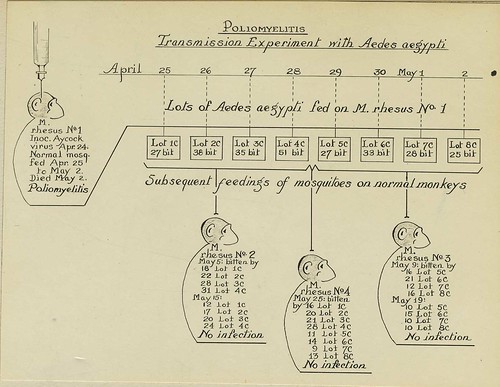
Poliomyelitis. Transmission Experiment with Aedes aegypti. (although polio is not transmitted by mosquitos).

ANTERIOR POLIOMYELITIS. (MICROPHOTOGRAPH.)
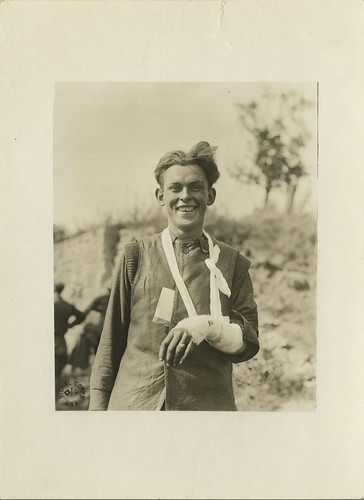
American soldier wounded but still happy. Boureuilles, Meuse, France. 09/26/1918.
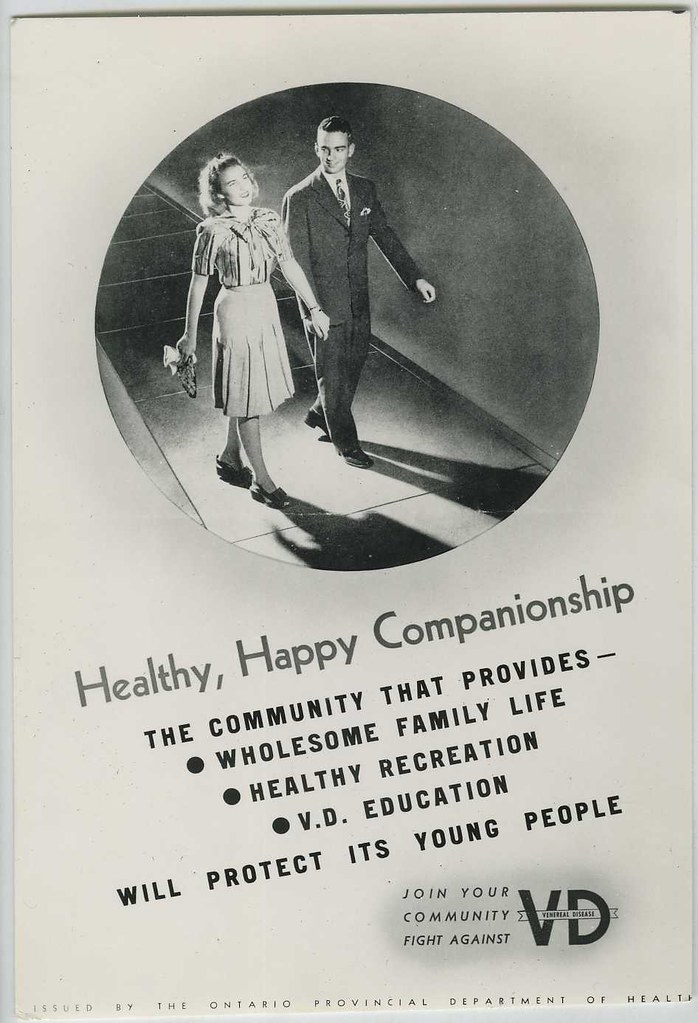
"Healthy, Happy Companionship. The community that provides - wholesome family life, - healthy recreation, - V.D. education will protect its young people." Ontario. Issued by the Ontario Provincial Department of Health, circa World War 2.

[summer night crowd watching motion picture, circa World War 1. "Fit to Fight" anti-venereal disease film showing?]
This one's been popular:

Poliomyelitis. Transmission Experiment with Aedes aegypti. (although polio is not transmitted by mosquitos).

ANTERIOR POLIOMYELITIS. (MICROPHOTOGRAPH.)

American soldier wounded but still happy. Boureuilles, Meuse, France. 09/26/1918.

"Healthy, Happy Companionship. The community that provides - wholesome family life, - healthy recreation, - V.D. education will protect its young people." Ontario. Issued by the Ontario Provincial Department of Health, circa World War 2.

[summer night crowd watching motion picture, circa World War 1. "Fit to Fight" anti-venereal disease film showing?]
Sunday, February 24, 2008
Another favorite photo
Here's another photo from the MAMAS collection (introduced below). Paperwork that came with the photo didn't have a name for this creature other than "mooch bug." I think, as a librarian/archivist, that it's a perfectly descriptive term, even if you wouldn't find in the Library of Congress Subject Headings.


Labels:
bugs,
cigarettes,
insects,
MAMAS,
Otis Historical Archives,
photographs,
World War 2
Saturday, February 23, 2008
Introduction to one of our collections
Hi. I'm Kathleen Stocker, an assistant archivist at the museum. I've been there about 2 1/2 years, fresh out of graduate school and my first foray into the archives world. I love my job.
I was hired to begin processing images for a massive digitization project. The first collection I worked on is known as MAMAS (Museum and Medical Arts Services). MAMAS photographers were sent out by the Medical Museum during WW2 to document medical and surgical cases and, when things got slow, they shot a lot of other things like scenery and calmer activities. Of the hundreds of thousands of images we've digitized in the last couple of years, here is my favorite:
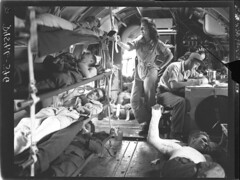
This is the only information we have about this picture: "C-46 air evacuation from Manila, Philippine Islands."
I think the photo's a classic. It portrays such a feeling of calm and control. The soldiers are obviously all wounded, but they're in safe hands now, maybe on their way home. Mundane activities occupy the sergeant at the desk. And the nurse looks like a 1940s movie star, with just enough light on her face to make her the real subject of this photo, an elegant emblem of caring and competence.
I was hired to begin processing images for a massive digitization project. The first collection I worked on is known as MAMAS (Museum and Medical Arts Services). MAMAS photographers were sent out by the Medical Museum during WW2 to document medical and surgical cases and, when things got slow, they shot a lot of other things like scenery and calmer activities. Of the hundreds of thousands of images we've digitized in the last couple of years, here is my favorite:

This is the only information we have about this picture: "C-46 air evacuation from Manila, Philippine Islands."
I think the photo's a classic. It portrays such a feeling of calm and control. The soldiers are obviously all wounded, but they're in safe hands now, maybe on their way home. Mundane activities occupy the sergeant at the desk. And the nurse looks like a 1940s movie star, with just enough light on her face to make her the real subject of this photo, an elegant emblem of caring and competence.
Labels:
MAMAS,
Otis Historical Archives,
photographs,
WW2
Pictures of the Museum, its exhibits and its environs

My friend Bruce Guthrie stopped up for a tour a few weeks ago. He's an amateur photographer and took a lot of shots of both the exhibit floor and behind the scenes.
 Julius Fabry's infected femur after George Otis' reamputation of it at the hip.
Julius Fabry's infected femur after George Otis' reamputation of it at the hip.In the behind the scenes shots, you can get a brief glimpse of all 5 collections - Archives, then Historical, Anatomical, Neuropathology and Human Developmental Anatomy. The pictures with an asterisk at the top - * - have a caption you can read by clicking on the pencil.
 Brain slices stained and mounted on glass for study.
Brain slices stained and mounted on glass for study. Civil War bones with the bullets that caused the damage still attached.
Civil War bones with the bullets that caused the damage still attached.Pictures of the Forest Glen Seminary are also on Bruce's site. This former girl's school was used by the Army as part of Walter Reed Army Medical Center during World War 2 and up through the 1990s before part of it was sold for development as condos. The rest is still owned by WRAMC and holds the Walter Reed Army Institute of Research which is doing important work on malaria vaccines. We've got some interesting bits in the Archives about the school, including this large WPA-era painting on display, showing psychiatric patients on the grounds.

Friday, February 22, 2008
Technology left behind, or an Intro to Our Neat Photos
 Once upon a time, when one used horses in battle, one had to protect them as well. Germany's use of poison gas in World War 1 meant that one had to have a gas mask for one's horse too. This is Reeve 17408 and can be downloaded full-size from our third Flickr site.
Once upon a time, when one used horses in battle, one had to protect them as well. Germany's use of poison gas in World War 1 meant that one had to have a gas mask for one's horse too. This is Reeve 17408 and can be downloaded full-size from our third Flickr site.
Subscribe to:
Posts (Atom)